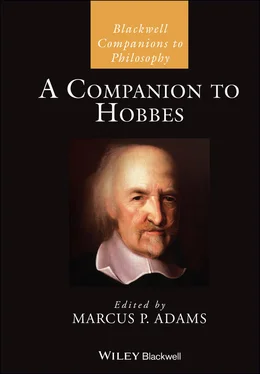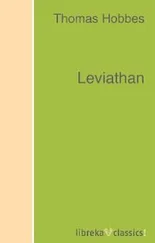Considering Hobbes’s presentation of topics exposes a key fault-line present in his thought: the line between natural bodies and political bodies. If readers attend just to the Table of Leviathan chapter 9, discussed already, and to the distinctions between the parts of Hobbes’s works, this line between the natural and the political may seem clear and unproblematic. But the line between these two kinds of bodies is not precise, for even if the “ Science of just and uniust” is part of the consequences from natural bodies, justice and injustice themselves do not result from human bodies considered on their own, unlike sensation or digestion. Indeed, Hobbes declares that “Justice, and Injustice are none of the Faculties neither of the Body nor the Mind” but are instead “Qualities, that related to men in Society, not in Solitude” (Hobbes 2012, 296; 1651, 63). This fault line in Hobbes’s thought figures in the discussions of a number of the chapters of the volume: Abizadeh (Chapter 6), Slomp (Chapter 7), Field (Chapter 8), Lloyd (Chapter 9), Green (Chapter 10), Brito Vieira (Chapter 11), and Rhodes (Chapter 12).
2.1 First Philosophy, Mathematics, and Natural Philosophy
Helen Hattab’s chapter “Hobbes’s Unified Method for Scientia ” contrasts Hobbes’s goal of a unified method for theoretical and practical science with his Scholastic predecessors. Hattab shows that Hobbes uses ‘demonstration’ equivocally and argues that this has led scholars to think Hobbes had a single form of method in mind. Hattab argues that in fact, for Hobbes and others, there are two types of method at play: first, a universal method concerned with the ordering of concepts and definitions before one begins the work of discovery or teaching in a subject; and second, a particular method used to demonstrate conclusions. The former method provides principles that are drawn upon in applications of the particular method. However, unlike the differences that Hobbes claimed existed between him and Scholastic Aristotelians, Hattab locates this distinction within Zaberella and shows that it was continued by Keckermann and Burgersdijk, Scholastic Protestant philosophers influential in England during Hobbes’s time.
There has been interest in the Stoic influences upon Hobbes’s political philosophy, but less attention has been devoted to the relationship of Stoic ideas to Hobbes’s first philosophy and natural philosophy. Geoffrey Gorham’s chapter “The Stoic Roots of Hobbes’s Natural Philosophy and First Philosophy” shows how Hobbes’s first philosophy was influenced by Stoic thought and how that influence impacted his natural philosophy, focusing in particular on Hobbes’s views of space, time, causality, and God. These areas of Hobbes’s philosophy were especially pressing for his materialism since they seem to be concerned with incorporeal entities. Indeed, as a result some have attempted to understand Hobbes as an idealist, a subjectivist, or an atheist. Gorham shows that Hobbes’s solution, in line with Hobbes’s goal of providing a materialism that cohered with mechanical philosophy, was to understand the conceptions that grounded first philosophy as having two aspects: realist and subjectivist.
Hobbes’s exalted view of himself as a mathematician did not align with the opinions of his contemporaries. Douglas Jesseph’s chapter “Hobbesian Mathematics and the Dispute with Wallis” examines Hobbes’s philosophy of mathematics and Hobbes’s continual disagreements with John Wallis. Jesseph focuses on Hobbes’s attempts to understand geometrical objects and geometrical definitions in accordance with his materialism and furthermore on Hobbes’s disdain for analytic geometry. Their exchanges relating to mathematics can be seen as originating in 1655 with the publication of De corpore and continuing until Hobbes’s death, and beyond issues in mathematics they also concerned broader issues in theology and politics.
Continuing the focus on the unity of Hobbes’s philosophy begun in Helen Hattab’s chapter, Marcus Adams’s chapter “Explanations in Hobbes’s Optics and Natural Philosophy” examines how Hobbes’s optics and natural philosophy depend upon his geometry. Adams considers Hobbes’s descriptions about how the parts of his philosophy fit together with one another and provides case studies to show Hobbes’s practice of explanation in optics and natural philosophy. Adams suggests that Hobbes held that explanations in natural philosophy should ideally be like those in optics, showing how Hobbes’s explanations in both employ claims from experience and from a priori geometry.
2.2 Human Nature and Morality
R.W. McIntyre’s chapter “‘A Most Useful Economy’: Hobbes on Linguistic Meaning and Understanding” directs attention to the human/non-human animal divide to make sense of the role of names in language. McIntyre argues that for non-human animals, like dogs and cats, names play the role of natural signs of the passions and the will. A dog, for example, will take an instance of the name ‘walk’ as a sign that their owner is about to get the leash and take them outside. However, for humans who are competent at using language names function as symbols that aid in helping bring to mind conceptions that will guide inferences and ultimately human behavior. Beyond aiding in the increase of prudence, this ability to understand words as words that Hobbes posits allows humans to acquire universal knowledge, e.g., of all triangles, while maintaining his commitment to nominalism.
In “Hobbes’s Theory of the Good: Felicity by Anticipatory Pleasure,” Arash Abizadeh shows how Hobbes’s account of felicity was influenced by and modified ideas from Ancient Greek ethics. Abizadeh argues that Hobbes posits an ultimate, overarching good for a human life, which Hobbes conceives not as a final end or state to be realized but as an ongoing process of experiencing greater pleasures relative to pains. Contrasting Hobbes’s understanding of felicity with that of the Epicureans and the Cyrenaics, Abizadeh depicts a Hobbes who holds that felicity consists primarily in the mental pleasures arising from anticipating the satisfaction of one’s desires.
The role fear plays in humans’ escape from their natural state, as well as within the commonwealth after it has been established, has always been a point of focus among interpreters of Hobbes. Gabriella Slomp, in the chapter “In Search of ‘A Constant Civill Amity’: Hobbes on Friendship and Sociability,” compares Hobbes’s views with Aristotle’s and shows how Hobbes’s account differs in terms of the origin, nature, and conditions of “civill amity” within political states. On Slomp’s account, what emerges is a picture of Hobbesian amity that results not from reciprocity of love or care but rather from a shared understanding of the function of the Leviathan and the effort among its citizens to support it.
In the chapter “Hobbes on Power and Gender Relations,” Sandra Leonie Field considers what Hobbes’s philosophy offers to help make sense of gender relations. Field distinguishes between two models of interpersonal power relations: the dominion model and the deference model. The dominion model, which represents power as a vertical relationship of the subjection of one person to another, has been frequently associated with Hobbes by feminist scholars. While this model is reflected in Hobbes’s writings, Field suggests that this model has difficulty making sense of gender relations in a post-coverture world. In its place, Field draws attention to the deference model, which understands the complex and often non-vertical ways in which power can be expressed in gender relations. Not only does this model better aid in understanding contemporary power relations, but Field shows that this model can be found within Hobbes’s thought.
Читать дальше












